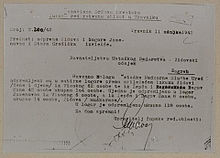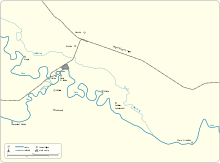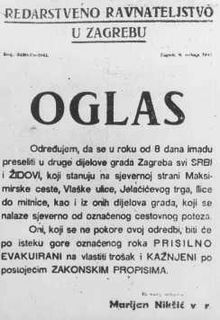Jasenovac concentration camp
The concentration camp Jasenovac (Serbo-Croatian Koncentracioni logor Jasenovac/Концентрациони Логор Јасеновац; Yiddish יאסענאוואץ; Hebrew יסנובץ) was the largest collection, labor, concentration, and extermination camp in the so-called Independent State of Croatia, and also one of the largest in Europe by prisoner numbers. It was the only extermination camp in Europe during World War II in which planned murder was carried out without German participation. In the camp complex of Jasenovac mainly Serbs died as well as Jews, Roma and opponents of the regime, among them Croats and Bosnian Muslims. The figures on the number of victims differ greatly due to their partial use for propaganda purposes.
The camp complex run by the Ustasha between 1941 and April 1945 was located 95 km southeast of Zagreb, near the village of Jasenovac, and stretched along the left bank of the Sava River from the mouth of the Una to Stara Gradiška. The information according to which the total area of the complex was up to 240 square kilometres is questionable, because it remains unclear what is meant by "complex". The camp complex consisted of a total of five subcamps (Jasenovac I-V) and three smaller camps. These included the three children's concentration camps Sisak as the largest, Gornja Rijeka as the smallest and Jastrebarsko.
On the site of the former camp is the memorial to concentration camp victims, built between 1959 and 1966 by Yugoslav architect and sculptor Bogdan Bogdanović.
Another concentration camp on the territory of the Ustasha state was the Sajmište concentration camp on the left bank of the Sava near Zemun, which was operated by the German occupation forces.
History
Background
The Balkan campaign, with the Axis invasion, led to the occupation and destruction of the Kingdom of Yugoslavia by German, Italian, Hungarian and Bulgarian troops between 6 and 17 April 1941. Originally, Germany had hoped to force neutral Yugoslavia into an alliance. As early as April 10, 1941, the Wehrmacht marched into Zagreb, whereupon Colonel Slavko Kvaternik, on behalf of the fascist Ustasha movement, proclaimed the puppet state of the Axis powers, the so-called Independent State of Croatia (NDH) under Adolf Hitler's and Benito Mussolini's protection, which also included Slavonia, Syrmia and almost all of Dalmatia, Bosnia and Herzegovina, and parts of Serbia. The proclamation of the new state was welcomed by the majority of Croats, but in this entity lived, in addition to the approximately 3.3 million Croats, about 3 million others, with about 1.9 million predominantly Serbs, but also 700,000 Muslims and a number of other ethnic minorities.
The NDH state also introduced racial laws in the style of National Socialist Germany. According to these, hundreds of thousands of Jews, Roma and especially Serbs were persecuted, imprisoned and murdered. In addition, about 40 concentration and internment camps were established on the territory of the state. The Ustasha, under its leader Ante Pavelić, established a totalitarian dictatorship that was responsible for the genocide of various ethnic groups and the murder of numerous political opponents. The relationship of the Roman Catholic Church to the Ustasha was ambivalent. Nationalist Catholic clergy from the NDH sympathized, cooperated or participated in the deeds of the Ustasha. Others protested against their crimes. The planned genocide, which claimed several hundred thousand lives, finally reached its climax in the Jasenovac concentration camp.
Origin
The camps were formally legalized on the basis of Croatian Law Order No. CDXXIX-2101-Z-1941 of 25 November 1941, issued by Ante Pavelić and signed by Justice Minister Mirko Puk. This law "permitted" the forcible arrest and internment of disliked persons in labour camps and thus the construction of concentration camps. The construction of the concentration camp was started at the end of 1941 by Eugen Dido Kvaternik, who as head of the Ustaška nadzorna služba (UNS), the state police and secret service of the NDH, was in charge of all camps. The founder and organizer of Jasenovac was General Vjekoslav Luburić, also the commander of the camp complex, called "Maks the Butcher". He had been to Sachsenhausen concentration camp for training, where he studied the camp's layout and the neck-shooting system for the systematic killing of Russian prisoners of war; he then tried to transfer this model to Jasenovac.
Between 1941 and 1945, there were about 40 concentration camps and killing sites on the territory of the NDH state. However, the smaller ones were quickly disbanded. Instead, Jasenovac was chosen as a central location, conveniently situated at the confluence of the Sava and Una, Strug and Lonja rivers to prevent escapes, and at the same time conveniently situated for a large camp complex near the Belgrade-Zagreb railway line. The main purpose was the extermination of Serbs, Jews and Roma together with their relatives and children, as well as the extermination of members of the Serbian Orthodox official church. In addition, the camp repaired tanks, produced leather goods for the Ustasha military and ship chains, among other things. A large brickyard was also located on the camp grounds. The labour, extermination and concentration camp was modelled on the German concentration camps and was soon nicknamed the "Auschwitz of the Balkans" because of its size. Above the main gate it read in Croatian "All for the Poglavnik" (by Poglavnik was meant the NDH leader Ante Pavelić) and below it "Labour Service of the Ustasha Defence - Collection Camp No. III".
Camp complex
The camp complex was subject to various changes until the spring of 1942 and consisted altogether of Jasenovac I (Krapje), Jasenovac II (Bročice), Jasenovac III (Ciglana), Jasenovac IV (Kožara) as well as the Stara Gradiška camp, known as Jasenovac V, which, however, had its own administration. Stara Gradiška mainly held women and many Croatian and Bosniak opponents of the regime.
Jasenovac I and II were built simultaneously in August 1941 and occupied by the first prisoners. At the end of October 1941, heavy rains began to fall on the area of the camp complex, which was still under construction. In mid-November 1941, the level of the Sava River rose and, after dam bursts, Jasenovac I (Krapje) sank and the entire camp complex was enclosed by water. According to survivors' reports, up to 550 prisoners drowned. In mid-November 1941 an admission freeze was imposed and the prisoners were evacuated to the higher-lying Jasenovac III (proper name: Sabirni logor Br. III), called Ciglana (Brickyard). The prisoners were housed in a large building of a brickyard because of the lack of barracks. Of the 3000 to 4000 prisoners in the two camps, only 1500 survived this transfer. Jasenovac III was the largest camp of the camp complex.
Forced labour and mass killings
At times, the camp also served as a collection camp for prisoners on their way to other extermination camps. At the same time, up to 5000 people were interned and had to perform forced labour.
Most of the victims brought in by cattle cars and trucks were taken directly from the railway terminus on the Sava River by ferry to the other bank of the river, to Donja Gradina (in present-day Bosnia and Herzegovina), where they were massacred. There were no gas chambers for this purpose. The killings were initially carried out with firearms, later mainly with knives, but also with hoes, hatchets, axes and hammers. A sheaf knife made by a German company was also used, which was called a Srbosjek (Serb cutter). The upper part of the knife was designed from leather, as a kind of glove. The lower part consisted of a 12 cm long and slightly curved blade with a sharpened inner concave side. With these and some other methods, the concentration camp was transformed into a slaughterhouse.
German military officers feared a strengthening of the resistance movement because of the cruelty used (General Edmund Glaise von Horstenau in a letter to Field Marshal Wilhelm Keitel in March 1942).
Final Phase
The end of the Jasenovac death camp cannot be precisely dated, but the Ustasha prepared its closure in April 1945, after the Yugoslav partisans attacked again and again to liberate the camp. The Red Army had also already advanced into Yugoslavia. On the evening of April 21, the last large group of 700 to 900 women were executed, after which some of the 1050 men still surviving planned to break out on April 22. Unarmed, 600 of them confronted the heavily armed Ustasha. 80 camp inmates managed to escape, the remaining 520 were killed during the escape attempt. 460 prisoners who had been too old, weak or sick to revolt and remained in Camp III were killed by the Ustasha. In the last days of April all the remaining concentration camp prisoners were murdered, documents and records were destroyed and the camp was blown up. On 2 May, units of the Yugoslav partisan army reached the burnt-down Jasenovac camp.
_used_in_Croatia_-_1941–1945.jpg)
A sheaf knife known as a Srbosjek (Serb cutter) was used by the Ustaše to kill prisoners at Jasenovac.

Deportation report from Travnik to Jasenovac and Stara Gradiška (March 1942)

Site plan of Camp III, called Ciglana (Brickyard), the main camp of Jasenovac.

Bearing with environment

Public request of May 1941 to Serbs and Jews to leave their homes in Zagreb
Warehouse personnel and law enforcement
The camp's leadership positions were filled primarily by Ustasha who came from exile, were loyal to Ante Pavelić and formed a sworn community with considerable experience of violence. Later, the camp staff was also recruited from nationalists who had joined the Ustasha and fellow travelers from the ranks of the Ustasha militia, who became accustomed to the violence, the killing and the massive consumption of alcohol in the camp.
The commanders of Jasenovac I and II, which existed from August to November 1941, were Ante Marić and Ivan Ranko.
The commander of Jasenovac III from the end of June to October 1942 was the former priest Miroslav Filipović (called "Brother Devil") who had previously been expelled from the Franciscan Order because of his involvement in the Banja Luka massacre. He was hanged in Zagreb in 1946. In the summer of 1943, the priest Ivica Brkljačić became camp commander. In addition, several Catholic chaplains and clergymen served in responsible and executive positions in Jasenovac, including Ivica Matković, as well as Matijević, Zvonko Brekalo, Čelina and Lipovac.
The temporary camp commander Dinko Šakić was extradited from Argentina to Croatia in 1998 at the age of 76. He was found guilty of war crimes against civilians as defined in the indictment, pursuant to Article 120(1) of the Croatian Criminal Code, by the Zagreb District Court in 1999 and sentenced to 20 years' imprisonment.
The camp management unsuccessfully fought the indiscipline and dissolution symptoms of the camp personnel, because the behavior of the camp Ustasche, who were used to corruption and arbitrariness, hardly changed as a result. In a large number of cases the camp personnel were investigated for embezzlement, robbery and rape, and a considerable number were executed for theft and receiving stolen goods. Dozens of men of the camp Ustasha were imprisoned by the camp administration in the prisoners' camp for various offences, so that this developed into a particularly brutal group of prisoners.
In addition to the organizational structure of the Ustasha camp staff, a second camp hierarchy emerged, as in the German concentration camps, with "function prisoners", which made the large number of concentration camp inmates more controllable and manageable. This included a group around Bruno Diamantstein (1906-1942; Jasenovac III) as well as Herman Spiller (Jasenovac V), Wiener, Mihić, Feldbauer, Begović, Pero Kolak and others, some of whom lived separately in the camp.

Ustasha camp personnel
Questions and Answers
Q: What was Jasenovac concentration camp?
A: Jasenovac concentration camp was the largest death camp and concentration camp in the Independent State of Croatia during World War II.
Q: Who were most of the people killed at Jasenovac?
A: Most of the people killed at Jasenovac were ethnic Serbs, who the ISC saw as their main racial enemy.
Q: Who else was held at Jasenovac?
A: The camp also held Jews, Roma, and a number of Croat and Bosniak Yugoslav Partisans and anti-Fascist civilians.
Q: How large was the complex that included Jasenovac?
A: The complex covered over 240 km2 (93 sq mi) on both banks of the Sava River.
Q: Where is Jasenovac located?
A: The largest camp was at Jasenovac, about 100 km (62 mi) southeast of Zagreb.
A What other camps were part of the complex that included Jasenovac? BThe complex included large grounds at Donja Gradina directly across the Sava River; a children's concentration camp in Sisak; and a Stara Gradiška concentration camp.
Q: How many victims are estimated to have been killed in Ustasha Camps in Jasenovac?
A: According to research completed so far, the number can be estimated at between 80,000 and 100,000.
Search within the encyclopedia